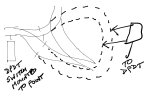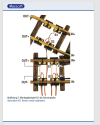Software Tools
Registered
I would use the LGB 55080 reversing loop units
The LGB 55085 or Massoth 8157001 is better, as it does not rely on a momentary short-circuit being created to activate the polarity switch.
I would use the LGB 55080 reversing loop units
Reverse loops naturally create a short circuit. You therefore need to isolate both of the rails of the reverse loop This reverse loop has to be long enough that there is no conflict with power pick ups at both the front of the train and the rear as Gizzy explained. Coaches and wagons with lighting can also cause problems so generally the reverse loop should be longer than your whole train. If it is just a loco that uses the power then the length of the reverse loop is irrelevant but who knows in the future what you may be running?This is my goal. I currently have a switch kat controlling the turnout with the nce power cab. Do you think I can make this work with the current setup or do I need to wire something else.

As Phil mentions, I'm not sure this is the case for DCC.View attachment 338836
Note the wiring will also work for DCC, just reverse the point whilst train traversing the loop and no other changes required.
This was the best I could do to get it to connect. Any suggestions? Putting the straight on the diverging side didnt allow me to connectYes, a long straight off both roads of the turnout to your slightly more than a half circle will give you a long return loop....
Less curves, just add an extra curve to turn past 180 deg, and more straights.This was the best I could do to get it to connect. Any suggestions? Putting the straight on the diverging side didnt allow me to connect
Ok tried the 9 still couldn’t connectLess curves, just add an extra curve to turn past 180 deg, and more straights.
I think it's 9 R3 curves....
You just need a short straight at the half way point of the curve, possibly LGB 10152 for Anyrail.Ok tried the 9 still couldn’t connect
It all depends what you are wanting to run - a reverse curve in LGB R3 isn't too bad, but what you could do, if you have space, is insert a short straight between the reverse curves, and an equal one the opposite side - that'll keep the geometry in order.This was the best I could do to get it to connect. Any suggestions? Putting the straight on the diverging side didnt allow me to connect
Something like this?You just need a short straight at the half way point of the curve, possibly LGB 10152 for Anyrail.
But in practise, the flex in the track will let you connect....
I have long trains like the ns rescue trian. I wanna say it’s 23” at least without cars. I just remember reading somewhere that you didn’t want the reverse turn and if you had to, at least put straights in. So my goal was to have a reverse loop with minimal reverse curvesIt all depends what you are wanting to run - a reverse curve in LGB R3 isn't too bad, but what you could do, if you have space, is insert a short straight between the reverse curves, and an equal one the opposite side - that'll keep the geometry in order.
I think you've hit the spike in the sleeper....Something like this?
Yep, I'd only seen your Mk1 diagram, and hadn't got as far as Mk2 - a better solution and a bit closer to prototypical track layout.I have long trains like the ns rescue trian. I wanna say it’s 23” at least without cars. I just remember reading somewhere that you didn’t want the reverse turn and if you had to, at least put straights in. So my goal was to have a reverse loop with minimal reverse curves
.............................. and includes a tight radius bend with check rails if I remember rightlyA few miles away to the north of Cambridge, is the city of Ely. To the north of the station and city limits, is Ely North Junction.
If you look at this on Google Maps or similar, you will see a prototypical 'balloon loop' which is very similar to your Anyrail plot.
It allows freight trains from NW England to route North to Kings Lynn and North East to Norwich without having to reverse and run round in Ely station....
I've been across the bridges and crossing at Queen Adelaide many, many times, and I've never worked out which line is which, I really ought to look at a map!A few miles away to the north of Cambridge, is the city of Ely. To the north of the station and city limits, is Ely North Junction.
If you look at this on Google Maps or similar, you will see a prototypical 'balloon loop' which is very similar to your Anyrail plot.
It allows freight trains from NW England to route North to Kings Lynn and North East to Norwich without having to reverse and run round in Ely station....

